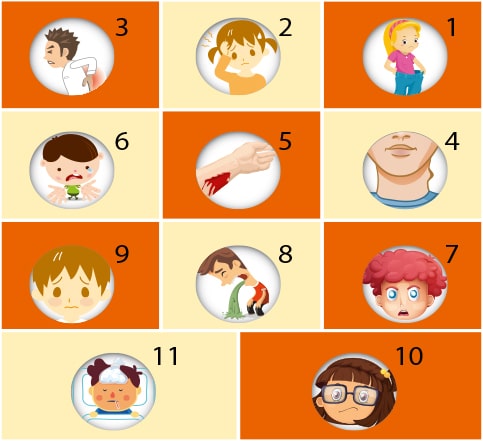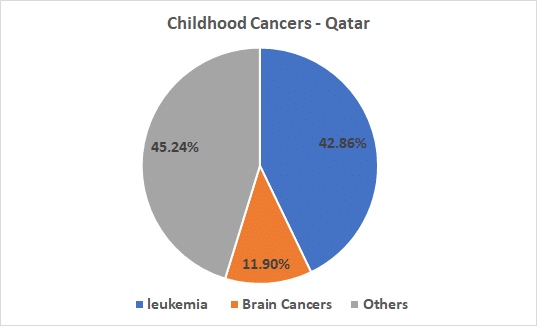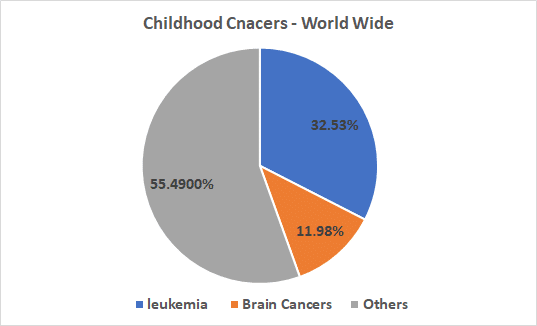Childhood cancers
- Different types of cancers that develop in children from birth to 14 years old
- Leukemia, Brain and central nervous system tumors are the most common cancers in children
- Environmental factors or individual behaviors do not play a role in developing childhood cancers but rather by genetic changes or mutations
- unexplained weight loss
- Headaches, often with early morning vomiting
- Increased swelling or persistent pain in the bones, joints, back, or legs
- Lump or swelling, especially in the abdomen, neck, or armpits
- Development of excessive bruising, bleeding, or rash
- Constant, frequent, or persistent infections
- A whitish color behind the pupil
- Nausea that persists or vomiting without nausea
- Constant tiredness or noticeable paleness
- Eye or vision changes that occur suddenly and persist
- Recurring or persistent fevers of unknown origin

You can reduce your child risk of cancer by:
- Minimize radiation exposure during pregnancy.
- Breast feeding for 6 months or longer, reduce your child risk of cancer.
- Make sure that your child is taking all scheduled vaccines.
- Help them adopt a healthy lifestyle with healthy eating habits and plenty of exercise to keep a healthy weight:
- Replace their unhealthy snacks with fruits, vegetables and nuts.
- Encourage them to play motor games instead of electronic games.
- Protect your child from smoking:
- Stop smoking during pregnancy.
- After birth protect them from passive smoking.
- Create a happy, laughter filled house; which will improve their immune systems.
- Keep your children safe during sun exposure (use the sun protection items: sunglasses, sunblock, long sleeves clothes, and wide hats).
- Keep healthy sleeping pattern for the children.
- If your child has any Signs and symptoms of Childhood cancer, it does not mean that they have cancer; if your child has any or some of the above symptoms t, it is important to have a check-up with your doctor in a regular manner.
Childhood cancers Statistics
Qatar National Cancer Registry (QNCR) – Ministry of Public Health- Qatar – 2016

- There were 42 child under 15 years old diagnosed with cancer.
- 62% of the cases were males, and 38% were females. Furthermore, 38.1% of the cases were Qataris, while 61.9% were Non-Qataris.
- Most common cancers among children are leukemia which represents 42.86% of all childhood cancers cases.
- brain and central nervous system which represents 11.9% of all childhood cancers cases.
- leukemia is the highest cause of cancer death among all childhood cancers.
Childhood cancers Statistics – Worldwide
International Agency for Research on Cancer (IARC) – World Health Organization- 2018

- There were 200166 child under 15 years old diagnosed with cancer.
- 26% of the cases were males, and 42.74% were females.
- most common cancers among children are leukemia which represents 32.53% of all childhood cancers cases.
- brain and central nervous system which represents 11.98% of all childhood cancers cases.
- leukemia is the highest cause of cancer death among all childhood cancers.
- one out of 667 child will develop cancer before age 15.
- + Risk factors
-
- Environmental factors or individual behaviors do not play a role in developing childhood cancers but rather by genetic changes or mutations
- + Early signs and symptoms
-
- unexplained weight loss
- Headaches, often with early morning vomiting
- Increased swelling or persistent pain in the bones, joints, back, or legs
- Lump or swelling, especially in the abdomen, neck, or armpits
- Development of excessive bruising, bleeding, or rash
- Constant, frequent, or persistent infections
- A whitish color behind the pupil
- Nausea that persists or vomiting without nausea
- Constant tiredness or noticeable paleness
- Eye or vision changes that occur suddenly and persist
- Recurring or persistent fevers of unknown origin

- + Prevention
-
You can reduce your child risk of cancer by:
- Minimize radiation exposure during pregnancy.
- Breast feeding for 6 months or longer, reduce your child risk of cancer.
- Make sure that your child is taking all scheduled vaccines.
- Help them adopt a healthy lifestyle with healthy eating habits and plenty of exercise to keep a healthy weight:
- Replace their unhealthy snacks with fruits, vegetables and nuts.
- Encourage them to play motor games instead of electronic games.
- Protect your child from smoking:
- Stop smoking during pregnancy.
- After birth protect them from passive smoking.
- Create a happy, laughter filled house; which will improve their immune systems.
- Keep your children safe during sun exposure (use the sun protection items: sunglasses, sunblock, long sleeves clothes, and wide hats).
- Keep healthy sleeping pattern for the children.
- + Screening
-
- If your child has any Signs and symptoms of Childhood cancer, it does not mean that they have cancer; if your child has any or some of the above symptoms t, it is important to have a check-up with your doctor in a regular manner.
- + Statistics
-
Childhood cancers Statistics
Qatar National Cancer Registry (QNCR) – Ministry of Public Health- Qatar – 2016

- There were 42 child under 15 years old diagnosed with cancer.
- 62% of the cases were males, and 38% were females. Furthermore, 38.1% of the cases were Qataris, while 61.9% were Non-Qataris.
- Most common cancers among children are leukemia which represents 42.86% of all childhood cancers cases.
- brain and central nervous system which represents 11.9% of all childhood cancers cases.
- leukemia is the highest cause of cancer death among all childhood cancers.
Childhood cancers Statistics – Worldwide
International Agency for Research on Cancer (IARC) – World Health Organization- 2018

- There were 200166 child under 15 years old diagnosed with cancer.
- 26% of the cases were males, and 42.74% were females.
- most common cancers among children are leukemia which represents 32.53% of all childhood cancers cases.
- brain and central nervous system which represents 11.98% of all childhood cancers cases.
- leukemia is the highest cause of cancer death among all childhood cancers.
- one out of 667 child will develop cancer before age 15.
